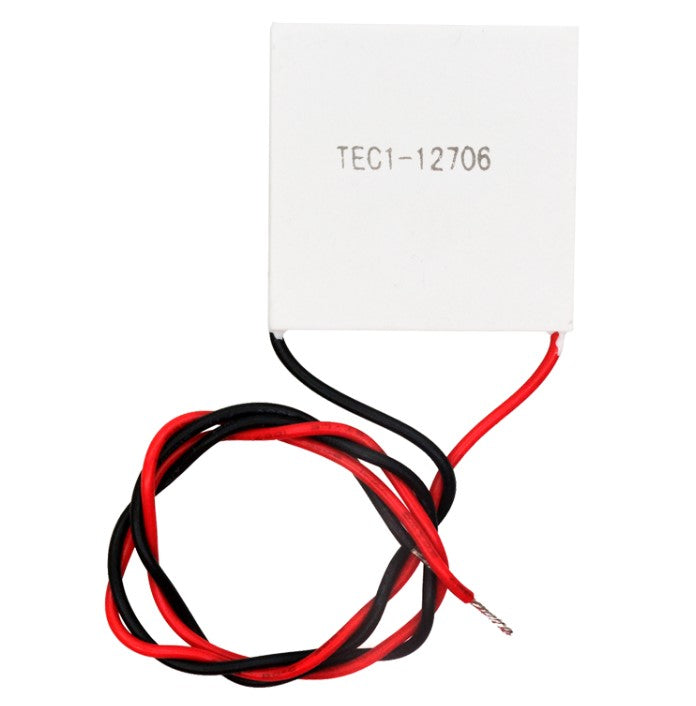Thermoelectric Cooler Peltier TEC1-12706
If you are searching for an efficient product to cool down your DIY projects, here is the ultimate destination for you! The TEC1-12706 Cooler Peltier features great qualities to bring the simple application of the Peltier thermoelectric Effect. This integration hosts 127 semiconductor couples that are placed in the area of 40 x 40 mm. Therefore, it cools and heats quite efficiently at up to 90 degrees Celsius.
Furthermore, Thermo Electric Cooling (TEC) is a semiconductor-based module that creates a temperature differential on each side. It brings effectiveness with one hot side and cooling on the other side. Consequently, the unit is quite beneficial when it comes to either warming something up or cooling something down. The desired result can be obtained using the respective side. Also, it allows you to use the temperature differential to produce electricity.
Thermoelectric Cooler Peltier TEC1-12706 is a semiconductor-dependent element that can work as a small heat pump. The system will transfer the heat from one side of the module to the other after applying DC power to a TEC. Therefore, it brings up the hot and cold sides. Some of the key areas where these systems are integrated include portable refrigerators, computer CPUs, medical instruments, CCDs, and many others. Depending upon the temperature difference, it can also be used to generate electricity by exposing it to different temperatures on both sides.
The TEC1-12706 40x40mm Thermoelectric Cooler 6.4A Peltier Module is the simple application of the Peltier Thermoelectric Effect. The module features 127 semiconductor couples in the area of 40mmx40mm which very effectively cools and heats up to 50°C.
Thermoelectric coolers are also known as TEC or Peltier Module create a temperature differential on each side. One side gets hot and the other side gets cool. Therefore, they can be used to either warm something up or cool something down, depending on which side you use. You can also take advantage of a temperature differential to generate electricity.
This Peltier works very well as long as you remove the heat from the hot side. After turning on the device, the hot side will heat quickly, the cold side will cool quickly. If you do not remove the heat from the hot side (with a heat sink or other device), the Peltier will quickly reach stasis and do nothing. We recommend using an old computer CPU heatsink or another block of metal to pull heat from the hot side. We were able to use a computer power supply and CPU heatsink to make the cold side so uncomfortable we could not hold our finger to it.
A thermoelectric cooling (TEC) module is a semiconductor-based electronic component that functions as a small heat pump. By applying the DC power source to a TEC, heat will be transferred from one side of the module to the other. It creates a cold and hot side. They are widely used in industrial areas, for example, computer CPUs, CCDs, portable refrigerators, medical instruments, and so on.
Also Known as Thermoelectric cooling modules, Thermoelectric modules, Peltier modules, and Thermoelectric cooling modules.
Features:
- Small module.
- Easy transition between the hot side to the cool side and vice-versa just by reversing the polarity of supply.
- Quality tested cooling cells.
- Solid state, vibration free, noise-free.
- Simple to install and operate.
- Should use with a heat sink.
Specifications:
- Model: TEC1-12706
- Maximum Voltage(Vmax): 14.4V - 16.4v
- Maximum Current(Imax): 6.4A
- Maximum Power (Qmax): 50W - 57W
- Module Resistance: 1.98-2.30Ω
- Hot Side Temperature (ºC): 25ºC- 50ºC
- Max. Operating Temperature: 138ºC
- Maximum Temperature Difference (△Tmax): 66°C - 75°C
- Dimensions: 40mm x 40mm x 3.8mm
- Life expectancy: 200,000 hours
Operating Tips:
- Do not exceed Imax or Vmax when operating module.
- Please carry out moisture protection options (sealing) in final application use.
- Failure rate based on longtime testings: 0.2%.
People Also Ask:
Q1: How to install a thermoelectric module?
- Verify the surface's quality before mounting a thermoelectric module there. Heat sink surfaces must be spotless, devoid of foreign objects and fat stains, and their non-flatness and ruggedness must not be greater than 0.02 mm.
- To the moistening wall surface of a heated heat sink, apply a continuous, even layer of thermo grease with a minimum thickness. Placing the Peltier module on the hot heat sink's prepared region with its hot side facing down requires caution and no mechanical force. Remove any extra thermal grease from the area where the module touches the heat sink and gently press the controller down until it is uniformly seated on the heat sink surface.
- The intended location of the thermoelectric module cold plate contact should be covered with a thin layer of thermal paste. Place the cold plate against the surface of the module.
- Use the necessary number of screws to maintain the module's attachment to the heat-conducting surfaces at a hold-down pressure of 13 to 15 kg/cm2. Such pressure offers the least heat resistance at the point of contact. The use of a torque wrench ensures controlled pressure. Give the completed construction an hour to stand. After this period of time has passed, check the hold-down pressure with torqueing screws and, if necessary, adjust it to the specifications.
- Make sure that the thermal grease layer thickness is approximately 0.03 mm and that the thermal grease heat resistance ranges from 0.03 to 0.05 °C/W under the aforementioned circumstances..
Q2: How can thermal pads be used to mount a thermoelectric module?
- Verify the surface's quality before mounting a thermoelectric module there. Heat sink surfaces must be spotless, devoid of foreign objects and fat stains, and their non flatness and stiffness must not be greater than 0.02 mm.
- Remove alien objects from your workspace and clean it. Prepare thermal pads with the necessary size that fit the surfaces of the thermoelectric modules.
- The thermal pad's protective coating should be removed. Place the pad on the surface of the module without touching the pad's working surface. Ensure that the pad completely encloses the module surface. Press the pad evenly against the module.
- For the other side of the module, repeat step 3 there.
- Put the module in place on the suggested contact area.(Note: Take off the protective film from the outer side of the pad when using pads with protective coating on both sides.)
- Use the necessary quantity of screws to maintain a hold-down pressure of 13 to 15 kg/cm2 that will keep the module attached to the heat-conducting surfaces. Such pressure offers the least heat resistance at the point of contact. The use of a torque wrench ensures controlled pressure. Give the completed construction an hour to stand. Once this period has passed, use torqueing screws to check the hold-down strain and, if necessary, modify it to meet the requirements.
Q3: What are the applications for TEC1-12706 generators?
- The following applications call for TEC1 Peltier modules when paired with an appropriate heat sinks and power source.
- Peltier TEC1 modules have been proven to cool CPUs and GPUs to extremely high levels when used in combination with 12V power rails and CPU-optimized heat sinks, making them ideal for high-performance PC applications.
- Use in temperature-sensitive food and drink heating and cooling applications needing extreme chilling is made possible by accurate temperature management (or heating).
- Peltier TEC1 modules can be used to control DTmax temperatures up to 75 °C because they are approved for commercial transportation
- When used in conjunction with a precise Peltier control module, stabilize volatile temperatures easily and with greater energy efficiency.
- TEC1 Peltiers provide unparalleled control for precision temperature control applications in research labs, academic institutions, and other settings with a range up to 68 °C.
- Peltier TEC1 modules provide first-precision climate control, even at extremely wide temperature variations, which few coolers can match. They are recognized in thousands of healthcare and optical system applications.
Q4: Can Peltier Modules be practically used to cool a room?
- A silent version of this gadget is possible (as long as the fans and pumps were very quiet)
- Can function with varying power sources (for example variable power output from a solar array)
- They can survive a great deal longer than a compressor if the system is correctly constructed (no moving parts)
Technical Details:
Thermoelectric Cooler Peltier TEC1-12706
Thermoelectric Cooler Peltier TEC1-12706
Out of stock
Product Code
SKU:AJ277
Couldn't load pickup availability


